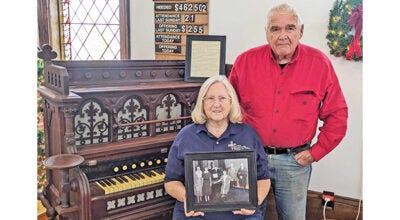Wood master finds Fernwood
Published 7:57 am Friday, August 9, 2013
By Kathee Kiesselbach
In the late 1400s a trend started in Germany that quickly spread to France, then on to England, of affixing small woodcuts into one’s books to identify them as your own. There were master artists of this quite small format, and they were some of the best. Albrecht Dürer, for example, created several bookplates, or ex libris, as they were also called.
Fernwood Botanical Garden in Buchanan recently had an exhibit of garden wood engravings from the UK and the US in which one of the best bookplate artists in the UK took part. And he never let on! Andy English, a professional wood engraver and very modest man didn’t even attempt to slip in a bookplate or two when he sent his entries in to the juried competitive exhibition. That is probably because his work is in such demand by private clients that he doesn’t have to look for work. He is happy to be able to keep up.
Andy English, born in 1956 in Norfolk, England, studied geology and taught for more than 20 years before he picked up wood engraving in 1991. He had been an artist for many years, having developed a firm habit of drawing often, but felt that this was the most natural art form for him that he’d ever tried. He often tells people it was more like remembering to do something than learning it. Six years later he was elected into the Society of Wood Engravers, a very well respected group of wood engravers that included Philip Hagreen, Robert Gibbings, Lucien Pissaro, Gwen Raverat, as well as the famed type designer Eric Gill (who himself did about fifty bookplates) when it was first formed around 1920. It was revived in the 1980s.
Using a 150 year-old Albion handpress, English prints his images-engraved on end grain boxwood-in his home studio in a small village in the Cambridge-shire Fens of England. He derives significant pleasure engraving in wood, but also from handling and using fine handmade papers. “So much suits me about wood engraving,” he told me, “the small scale, the detail, the restriction to black and white, and the way it can capture the rural environment I love.”
A full-time wood engraver, English describes himself as being “an engraver for hire, making illustrations, bookplates, commercial images (wine bottle labels) as well as my own personal work.” His work is clean and precise, the cuts most often in “white line,” a phrase used to describe the look of drawing with light. His cutting and printing are professional; his composition perfect. His subjects are those he loves, all seen within just a short distance from his rural home: country dogs and chickens, garden benches, ceramic rhubarb forcers and bee skeps, scurrying hedgehogs, manicured gardens; his quaint English garden scenes are gorgeous; his water scenes are filled with solitude and grace; his bookplates are timeless.
English is also quite fond of depicting children playing or exploring in the wood (he and his wife have two lovely sons who served as models for many years), or rivers flowing under rural bridges, as well as English villages skylines in the distance. He is the epitome of the classic English wood engraver.
English is featured in several books about ex libris and continues to be one of the most prolific of wood engravers who do ex libris in the UK. He is also a member of the Wood Engravers’ Network, an international organization based in Ann Arbor, Michigan. You can see his work her on his web site at www.andyenglish.com, or on his Facebook page, Andy English, Engraver and Illustrator.





